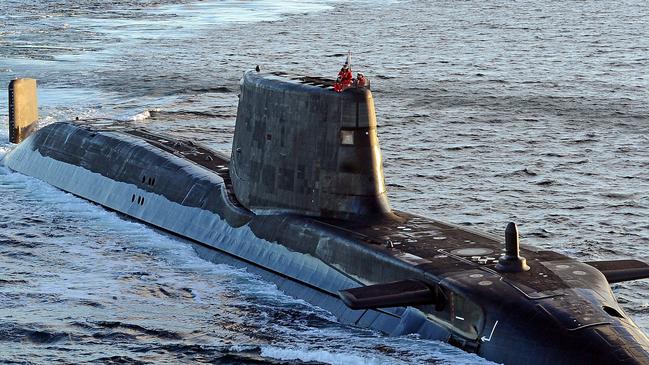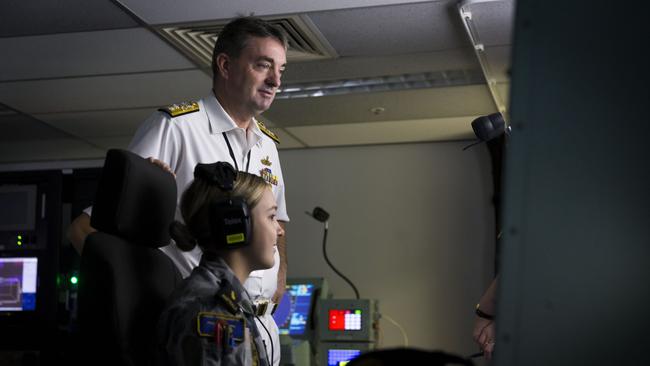Time to push the boat out on a bold nuclear submarines plan
Planning and delivering major investment projects is Australia’s stock-in-trade. With the right people in charge, the AUKUS submarine deal can be a success.

The Morrison government should be congratulated on its bold and far-sighted initiative to acquire nuclear-powered submarines (or SSNs) for the Royal Australian Navy.
Although SSNs are based on a mature technology, only six nations operate them. Of the six, only India is not a permanent member of the UN Security Council. All six countries have stronger defence forces than Australia and, apart from Russia, substantially larger economies with a bigger industrial base. They also all have a nuclear power industry.
As a middle power without civil nuclear power generation, Australia is seeking to step up to a very exclusive club. While substantial, the challenges involved are by no means insuperable, but success in overcoming them will require a clear plan and strong leadership.
Ideally, we need a whole of nation endeavour led by an exceptional individual reporting to the prime minister.
Over the next 18 months, a task force within the Department of Defence, led by Vice-Admiral Jonathan Mead, will explore possible pathways to delivering this highly complex technology to the navy.

Acquiring the submarines themselves will be challenging enough – it will take two decades – but some of the other requirements for making an effective transition to operating and maintaining SSNs may be equally demanding.
First, Australia will need to develop a substantially larger workforce, both onshore and in the submarine force itself, with a large number of nuclear-trained engineers and technicians.
The number of submariners will need to grow from the present 900 to more than 2000, with a long pipeline required to deliver a cohort of senior and experienced sailors when the SSNs enter service.
We cannot grow the uniformed submarine workforce without being able to send more people to sea, not just on training voyages, but on the high-intensity naval operations that Australian submarines undertake.
Second, Australian industry needs to redevelop the skills required to build submarines in Australia. The publicly owned company ASC last delivered a new submarine in 2003. Although the sections containing the nuclear reactor will likely be imported, the government intends to build the other modules for the SSNs in Australia and consolidate the submarines in Adelaide.
Third, as set out by every government since 2009, in Australia’s increasingly threatening strategic circumstances we need a greater submarine capability, not just in the 2040s, when the SSNs will become available, but much sooner than that.
Extending the life of the Collins-class
The Defence Department’s recent evidence to a Senate committee suggests the federal government intends to transition to SSNs delivered in the 2040s mainly by extending the life of the six existing Collins-class submarines.
The Collins-class boats have provided excellent service but are approaching the end of their design life. If they are to continue to perform effectively and with reduced vulnerability in the face of an increasingly capable adversary, they will require a comprehensive upgrade.
This involves substantial risks. Replacing major systems in a submarine can have extensive, and sometimes unforeseen, consequences for other systems as well. Also, Australian submarines are worked hard. They undertake long and distant operations and consistently travel much further each year than other nations’ conventional submarines. This punishing regime takes its toll on every system in the boat and may well affect the limit of the feasible life extensions.
Defence’s suggestion in the Senate recently that Collins might require two life extensions is preposterous and can only reflect bad advice. The idea that we can transition directly from our six, ageing Collins-class boats to a powerful force of SSNs in the 2040s is beyond fanciful.
Unless we acquire new conventional boats, there is a substantial risk of finding ourselves with no deployable submarine capability at all. At best, there will be no foundation on which to grow the much larger submarine force we need.
Our submarine building expertise will fade further into history. The ADF’s only offensive force projection capability will no longer constitute a credible deterrent. This would make the acquisition of SSNs far more difficult, if not impossible, to achieve.
In addition to these vital issues, building new conventional submarines would provide a hedging strategy against the possibility both of the failure of the life extension to deliver submarines capable of high-intensity operations and of delays in the SSN program.
Building more conventional submarines
Nevertheless, even if we proceed immediately, it is unlikely that the first new conventional submarine could be commissioned before 2032. That doesn’t mean it’s not worth doing. It means we have to start now.
With the exception of Collins, there is no conventional submarine in service globally that can meet the RAN’s requirements for blue water capability in regard to range, endurance and interoperability. Realistically, a Collins derivative is the only practical avenue available to acquiring a new conventional submarine in an acceptable time frame and without the cost and effort of developing the capacity to operate a third family of submarines.
We can’t afford to wait for the Mead task force to report. The Morrison government must act now. It should commission ASC and the Collins designer, Saab Kockums, to produce a preliminary design study for a Collins derivative, leading to a fixed price tender and a construction schedule within 12 to 18 months.
Acquiring second-hand nuclear-powered submarines
One possible reason why the government is not seeking to acquire new conventional submarines is that it is investigating the possibility of leasing second-hand SSNs from overseas.
This seems an unlikely prospect. The US Navy is currently short of submarines and the British Trafalgar-class is overdue for retirement. Even if second-hand SSNs were available, Australia currently could not operate or maintain them. That is why we need a staged transition from a force of conventional submarines to the step up to nuclear propulsion.
Nevertheless, should the government decide to acquire British SSNs, as we expect, it could investigate the possibility of acquiring an Astute-class submarine from the UK, perhaps in around 2030. One condition would be that Australia had established the infrastructure and human resource base by then necessary to operate and maintain an SSN. Another would be that the submarine would be a state-of-the-art vessel suitable for deployment on operations and interoperable with allied forces. If these conditions were satisfied, this might offer a valuable means of facilitating the transition.
Governance: a whole of nation endeavour
The SSN program should not be led by Defence. Even if the department had an unblemished record in naval procurement, which it clearly does not, the scope and complexity of this project are beyond its capability. The department does not have the capacity to plan, evaluate and manage a public investment project of a magnitude probably rivalled in Australia’s history only by the Snowy Mountains Scheme.
Nevertheless, planning and delivering major investment projects is Australia’s stock-in-trade. In projects such as the North West Shelf and the huge developments in the Pilbara, Australian industry has consistently demonstrated world-class capability. Of course, subject matter experts, such as engineers, play a very important role in these projects, just as shipbuilders, naval engineers and submarine specialists will provide critical advice in the SSN acquisition.
One option is to establish a Naval Shipbuilding Authority to govern the industry and leverage off these well-established industrial capabilities. It would have a board composed mainly of prominent Australians with a record of achievement in delivering complex investment projects. The board should report to the prime minister through the National Security Committee of Cabinet.
Commodore Paul Greenfield (RAN retired) was formerly a naval engineering officer who headed the Secretariat to the McIntosh/Prescott Review of the Collins-class and was a principal of the Coles Reviews; Jon Stanford is principal of the think tank Submarines for Australia and was formerly a senior official in the Department of Prime Minister and Cabinet.






To join the conversation, please log in. Don't have an account? Register
Join the conversation, you are commenting as Logout